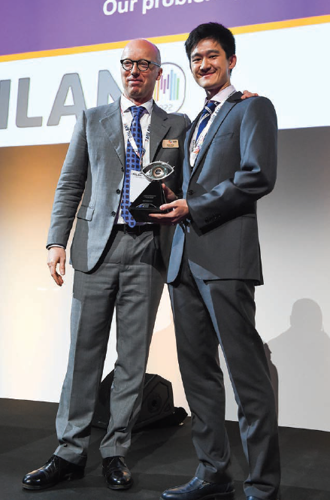Henahan Prize 2022 - Nostra Culpa
Our problems, a global issue

By George Liu MD
This essay was the winner in this year’s ESCRS Henahan Prize Essay Competition. Writers were asked to address the question, “What can the field of ophthalmology do to meet the pressing challenges of climate change, sustainability, and social equity?”
The United Kingdom’s National Health Service (NHS) contributes towards 5% of the country’s carbon footprint. They are not alone. If global health services formed their own country, they would be the fifth-largest carbon emitter on the planet. This is a global issue.
In ophthalmology, patients often present with chronic disorders needing multiple consultations (generating travel emissions), and often, surgical procedures are the only solution. Whilst there is a beneficial high turnover of surgical cases in ophthalmology, this also incurs increased waste generation, which is exacerbated by unsustainable practices such as disposable equipment, including substantial amounts of plastic and iron ore. To make matters worse, an NHS investigation showed that children were being exploited to manufacture surgical equipment in Pakistan. So perhaps reusable sterilised equipment is the way forward?
Whilst this appears to be the obvious answer, a study in Chicago, Illinois, US, showed that the use of ethylene oxide was likely causing higher rates of cancer in residents living near the sterilisation factory site. Furthermore, disposable equipment is often significantly cheaper to manufacture compared to reusable equipment, which incurs further sterilisation costs. Therefore, how can we safely balance sustainability and public health whilst making surgery financially viable?
Globally, approximately 43 million people are blind. A third of this population is blind due to cataracts—and this figure is set to increase due to the ageing population. However, the only definitive treatment for cataracts is surgery. A technique called Life Cycle Analysis (LCA) quantifies the emissions generated across the life cycle of a product in units of carbon dioxide equivalents (CO2e) and can be used to estimate the impact of cataract surgery. The LCA of a cataract surgery is 181.8 kg CO2e, with the greatest portion (54%) generated from the procurement of supplies. This LCA is the equivalent of driving a car for 500 km, a significant carbon footprint.
Similarly, international ophthalmology conferences also have a major carbon footprint. Transport, venue, catering, workshops, and presentations all contribute towards increased carbon emissions. Again, a balance must be established in an effort to maximise education whilst reining in personal interests such as tourism.
The aggregate of these issues contributes significantly to climate change. The effects of pollution, as studied by King’s College London, show that on high pollution days, there are 673 additional out-of-hospital cardiac arrests and hospital admission for stroke and asthma. If we were to apply these figures to the population of poorer countries, whilst the impact may be the same, their inability to access affordable healthcare generates an international injustice. Therefore, we need to push for global change.
OUR SOLUTIONS, A WORLDWIDE EFFORT
Whilst our community may strive for change, we are limited by our lack of actionable data.
However, the recent development of applications, such as “Eyefficiency”, encourages research into the environmental impact of cataract surgery by individual surgical units, thus generating the actionable data needed for change.
Variations in the LCA of cataract surgery depend on the surgeon, but there is no correlation between surgical outcomes and environmental cost, as shown in different locations around the world. Thus, suggesting that opportunities for more sustainable practice are available without having to sacrifice the quality of care. The Aravind case study showed that cataract surgery was achievable at 5% (23 km by car) of the LCA in the West with no increased risk and significantly reduced waste. However, efforts to pursue a similar case study in the West would be limited by regulations and Western patient perceptions of needing over-personalised care. More recently, the ophthalmic community has increasingly moved to Immediately Sequential Bilateral Cataract Surgery (ISBCS), which has reduced travel emissions that would normally be incurred from a second cataract surgery. Whilst this is a fair improvement, the combination of the Aravind study and ISBCS would provide the most sustainable outcome.
With the boom in technology during the pandemic, healthcare events are more accessible than ever—from the comfort of one’s own home.
Therefore, conferences should be hybrid by default, offering in-person attendance for local delegates and virtual attendance for international delegates. For those in attendance, efforts should be made to offset travel-related emissions. Those using renewable energy should be rewarded with reduced registration fees.
In a similar vein, these advances should be utilised in virtual consultations and other modalities to educate our patients. Ufonia artificial intelligence software conducts telephone postphacoemulsification consultations and greatly reduces anxious patients presenting to “Accident and Emergency” unnecessarily.
Everything exists in fine balance, and we are currently tipping the scale towards an unsustainable future. We should encourage selflessness and sustainability and change our culture of viewing Earth as an infinite resource. We must grasp these opportunities to stop climate change and accept that evolution may include regression in some aspects of our lives. Our response will determine our survival.
George Liu is a 4th Year Medical Student, Chelmsford, Essex, Tongdean Eye Clinic, UK.
